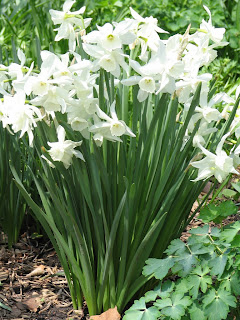
These are some of the best low maintenance perennials in the landscape. Plant them in the right spots in fall and watch them bloom next year. Your only maintenance chore is cutting back the flowers when they fade and cutting back the foliage when it yellows. These bulbs don’t need fertilizer, especially if they are planted in decent soil. That’s it! And these bulbs are big enough that a few here or there can make quite an effective show – so you don’t need to plant them by the hundreds or the thousands.
The cheery blooms of daffodils begin to appear in early April. They range in height from a few inches to about 1 ½ feet tall. The flowers are usually a bright yellow, but are also available in white and orange. Sometimes the flowers are fragrant. They are best planted in sites with well-drained soils that receive plenty of sun in spring. Daffodils are not bothered by deer or other animals.
Ornamental onions have globe-shaped flowers in late May and June. Flowers may be lavender, bluish-purple, white, or yellow. Because the flowers are not as bright as daffodils, they won’t be noticed as readily from a distance. But what they lack in striking color, they can make up in size. The flower clusters, or inflorescences, of some species of ornamental onions can be more than 10 inches across and can vary greatly in height from a few inches to three feet tall, depending on species. Onions will bloom best in sunny sites with well-drained soils. Because the foliage of many species of ornamental onions begins to fade and brown when they are blooming, plant the bulbs between shorter plants. This will help hide any unsightly foliage.

There are several different groups of lilies with flamboyant flowers in July. Flower colors range from brilliant oranges, reds, and golden hues to more muted pastel pinks, lavenders, and whites. Look for Oriental or Trumpet (or the hybrid Orienpet) lilies for fragrant flowers in a wide variety of colors. Only a few bulbs in areas near building entrances/exits are needed to fully appreciate their fragrance. Most lily species insist on sunny sites with well-drained soils. Some of the taller cultivars might require staking – so select shorter cultivars to limit maintenance needs.

Try one of these bulbs – or try all four. Either way, I don’t think you will be disappointed with the flower displays next year.
Cindy Haynes
Iowa State University


.png)
























